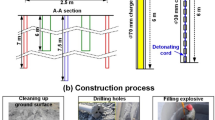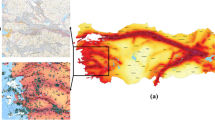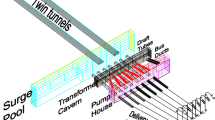Abstract
The paper describes the influence of shear seam on the equivalent continuum dam-foundation system of a concrete gravity dam, as observed through elasto-plastic analyses. Discrete element analyses have been carried out using UDEC by idealizing the foundation as an equivalent continuum. Multiple scenarios for analyses have been simulated under varying magnitudes of seam width, seam location and seam orientation \((\theta_{s} )\). Analysis has been carried out for two specific static load combinations as per IS: 6512 (1984), viz., (i) Loading condition ‘A’ (construction condition), \(LCA\), and (ii) Modified loading condition ‘B’ (normal operation condition), LCB. It is observed that due to the presence of a seam, the stresses and displacements are affected in the dam and foundation in the vicinity of the seam. The vertical deformation at the mid-point of the seam, \(\delta_{ys}\), at the dam base is compared with the vertical deformation at the same location in the absence of the seam, \(\delta_{y}\). A seam influence factor (\(I_{f}\)), defined as the ratio of \(\delta_{ys}\) to \(\delta_{y}\), is calculated for each case, to study the impact of the seam. Relative assessment of seam influence factors across different scenarios has been performed to arrive at the design implications emerging from the study. It is observed that the seam influence factor increases with increase in the seam width, under all simulation conditions, hence implying that wider seams are more critical. Further, it is concluded that seams at certain locations and seams of certain orientations are more critical than the others-seam orientations of 90 and 120° are the most critical for \(LCA\) and \(LCB\) respectively, and, seam location at the heel of the dam is most critical for both loading conditions.




















Similar content being viewed by others
References
Ajalloeian R, Dardashti AF (2013) Evaluation of fluid flow from a dam foundation using numerical modeling technique by UDEC software. Electron J Geotech Eng 18:1787–1800
Anand A, Kumar S, Tripathi V (2017) Shear zone treatment at dam foundation level. Am J Civil Eng 5(6):352–357
Barla G, Ballatore S, Chiappone A, Frigerio A, Mazzà G (2006) The Beauregard dam (Italy) and the deep-seated gravitational deformation on the left slope. In: International conference hydropower, Kunming, China, 1: 23–25
Bretas EM, Lemos GV, Lourenco PB (2014) A DEM based tool for the safety analysis of masonry gravity dams. Eng Struct 59:248–260
Callari C, Fois N, Cicivelli R. (2004) The role of hydromechanical coupling in the behavior of dam foundation system. In: Proceedings of the VI world congress on computational mechanics, Pequim, China 1–111
Cammarata G, Fidelibus C, Cravero M, Barla G (2007) The hydro-mechanically coupled response of rock fractures. Rock Mech Rock Eng 40(1):41–61
Chen SH, Yang ZM, Wang WM, Shahrour I (2012) Study on rock bolt reinforcement for a gravity dam foundation. Rock Mech Rock Eng 45(1):75–87
Dolezalova M (2004) Numerical analysis of an old masonry dam using UDEC, Num Model Discret Mater 269–277
Farihna B, Lemos JV, Neves ME (2012) Analysis of foundation sliding of an arch dam considering the hydro mechanical behavior. Front Struct Civil Eng 6(1):35–43
Gimenes E, Fernández G (2006) Hydromechanical analysis of flow behavior in concrete gravity dam foundations. Can Geotech J 43:244–259
Goodman RE, Ahlgren CS (2000) Evaluating safety of concrete gravity dam on weak rock: Scott dam. J Geotech Geoenviron Eng 126(5):429–442
Hoek E, Brown ET (1997) Practical estimates of rock mass strength. Int J Rock Mech Min Sci 34(8):1165–1186
Huang J, Zerva A (2013) Earthquake performance assessment of concrete gravity dams subjected to spatially varying seismic ground motions. Struct Infrastruct Eng 10(8):1011–1026
I Prakash, AB Vyas, (1988) Geotechnical problems and treatments of weathered rock seams occurring in the foundation of Karjan Dam West India. In: Proceedings of Fourth international conference on case histories in geotechnical engineering, Paper No pp 2–07
ICOLD (2005) Dam foundations: Geologic considerations, Investigation methods, Treatment, Monitoring. Bulletin 129. International commission on large dams. Paris
IS 6512. (1984) Criteria for design of solid gravity dams. Bureau of Indian Standards, New Delhi
Jiang S, Du C, Yuan J (2011) Effects of shear keys on nonlinear seismic responses of an arch-gravity dam. Sci China Technol Sci 54(1):18–27
Kovári K, Arn T, Gmünder C (1989) Groundwater flow through fissured rock: field investigations and interpretation in the Albigna Dam area, Graubünden, Switzerland. Nationale Genossenschaft für die Lagerung Radioaktiver Abfälle (NAGRA), Baden, Switzerland
Kulhawy FH (1975) Stress deformation properties of rock and rock discontinuities. Eng Geol 9:327–350
Liu YR, Guan FH, Yang Q (2013) Geomechanical model test for stability analysis of high arch dam based on small blocks masonry technique. Int J Rock Mech Min Sci 61:231–243
Liu X, Wang S, Wang E (2011) A study on the uplift mechanism of Tongjiezi dam using a coupled hydro-mechanical model. Eng Geol 117(1):134–150
Małkowski P (2015) Behaviour of joints in sandstones during the shear test. Acta Geodyn Et Geomater 12(4):399–410
Ng KLA, Small JC (1997) Behavior of joints and interfaces subjected to water pressure. Comput Geotech 20(1):71–93
Palta BR, Aggrawal SK (1967) Foundation problems at Bhakra Dam and their treat. 9th ICOLD, Istamboul pp 32–66
Ramamurthy T (2014) Engineering in rocks for slopes, foundations and tunnels. PHI Learn Pvt, Ltd
Ramamurthy T, Rao G, Singh J A (1988). Strength criterion for anisotropic rocks. In: Fifth Australia-New Zealand conference on geomechanics : Prediction Versus Perform, Preprints of Papers Inst Eng 253
Reddy K, Basavaraj C et al (1982). Design of a 101 m high concrete gravity dam on complex geological foundation pp 53–48
Singh B, Goel RK, Jethwa JL, Dube AK (1997) Support pressure assessment in arched underground openings through poor rock masses. Eng Geol 48(1–2):59–81
Song S, Feng X, Rao H, Zheng H (2013) Treatment design of geological defects in dam foundation of Jinping-I hydropower station. J Rock Mech Geotech Eng. 5(5):342–349
Stefano U, Yin Z, Jiang M (2008) Influences of hydraulic uplift pressures on stability of gravity dam. Chin J Rock Mech Eng 27(8):1554–1568
Tiwari RP, Rao KS (2006) Post failure behaviour of a rock mass under the influence of triaxial and true triaxial confinement. Eng Geol 84(3–4):112–129
UDEC. (2011). Universal Distinct element code: User’s Manual. Itasca C.G. Inc., Version 6.0, Minneapolis
Varadarajan A, Sharma KG (1989) Effect of a shear seam in the foundation of Karjan Dam. Int J Numer Anal Meth Geomech 13(4):435–442
Vergara MR, Jan MVS, Lorig L (2016) Numerical model for the study of the strength and failure modes of rock containing non-persistent joints. Rock Mech Rock Eng 49(1):1211–1226
Wang X, Zhao Y, Lin X (2011) Determination of mechanical parameters for jointed rock masses. J Rock Mech Geotech Eng 3:398–406
Wei Z, Xiaolin C, Chuangbing Z, Xinghong L (2008) Failure analysis of high concrete gravity dam based on strength reserve factor method. Comput Geotech 35(4):627–636
Xuhua R, Jiaqing S, Nenghui B, Hongyun R (2008) Stability analysis of concrete gravity dam on complicated foundation with multiple slide planes. Water Sci Eng 1(3):65–72
Y Cheng (1987) New development in seam treatment of Feitsui arch dam foundation. In: Proceedings of Sixth international congress of rock mechanics, 1, Montreal, Canada, 319-326
Yan F, Xinbin T, Li G (2004) The uplift mechanism of rock masses around the Jiangya dam after reservoir inundation, China. Eng Geol 76:141–154
Yu X, Zhou YF, Peng SZ (2005) Stability analysis of dam abutment by 3-D Elasto-Plastic Finite-Element method: A Case Study of Houhe Gravity-Arch Dam in China. Inter J Rock Mech Min Sci 42:415–430
Yuan C, Lin Z, Baoquan Y, Jianhua D, Jianye C ((2015)) Geomechanical model test on dam stability and application to Jinping High arch dam. Inter J Rock Mech Min Sci 76:1–9
Author information
Authors and Affiliations
Corresponding author
Rights and permissions
About this article
Cite this article
Kanupreiya, Manna, B. & Sharma, K.G. Deformation Response of Dam-Foundation System of Concrete Gravity Dam Due to Presence of Shear Seams in Rock Foundation. Iran J Sci Technol Trans Civ Eng 46, 3217–3240 (2022). https://doi.org/10.1007/s40996-022-00885-y
Received:
Accepted:
Published:
Issue Date:
DOI: https://doi.org/10.1007/s40996-022-00885-y




